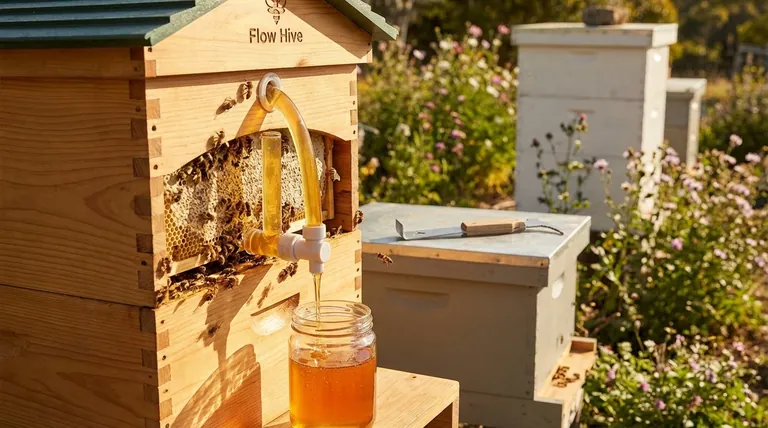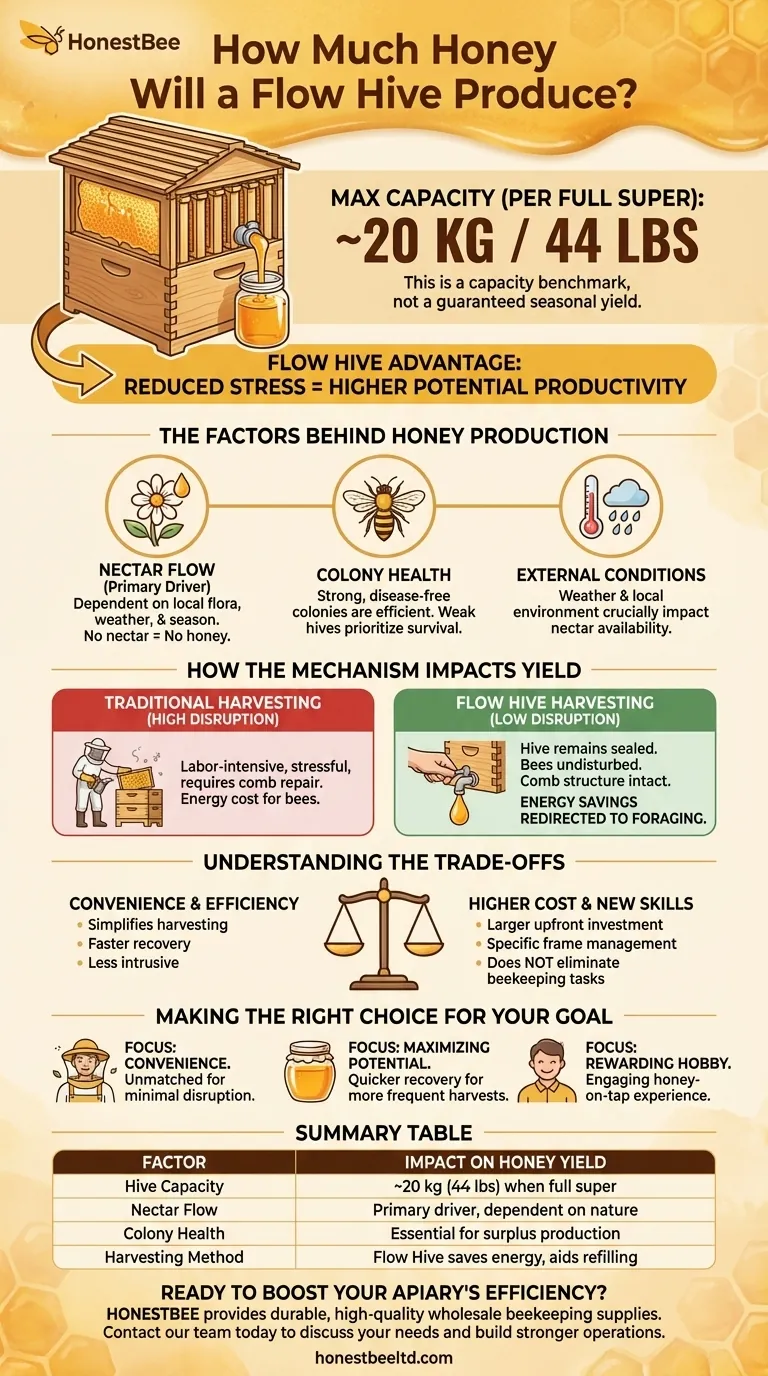To be direct, a standard seven-frame Flow Hive super can produce approximately 20 kg (about 44 lbs) of honey when it is completely full. This figure, however, represents the hive's maximum capacity for a single harvest, not a guaranteed seasonal amount. The actual yield is governed by a range of factors far beyond the hive itself.
Your question is about a number, but the real answer lies in understanding the mechanism. The Flow Hive's primary advantage is not that it magically creates more honey, but that its harvesting method dramatically reduces stress on the bees, which in turn can lead to higher overall productivity in a healthy, well-managed colony.

The Factors Behind Honey Production
The 20 kg figure is a useful benchmark, but it's a potential, not a promise. The amount of honey you can harvest is fundamentally tied to the health of your bees and the quality of their environment.
It's a Capacity, Not a Guarantee
The advertised yield refers to the volume of a full honey super. Whether the bees fill it once, twice, or not at all in a season depends entirely on external conditions. A beginner beekeeper in a region with poor forage might harvest very little, while an experienced one in a nectar-rich area could achieve multiple harvests.
The True Source: Nectar Flow
Honey production begins outside the hive. It is entirely dependent on the availability of nectar from flowering plants, which is influenced by weather, season, and local geography. No hive, regardless of its design, can produce honey if there is no nectar for the bees to collect.
Colony Health is Paramount
A strong, populous, and healthy colony is an efficient workforce. A hive weakened by pests like Varroa mites, disease, or poor nutrition will prioritize its own survival and brood-rearing over storing surplus honey. Successful honey harvesting begins with excellent beekeeping, not a special type of box.
How the Flow Hive Mechanism Impacts Yield
The innovative design of the Flow Hive is what sets it apart, and its primary impact is on the harvesting process itself. This is where the potential for increased productivity lies.
The Harvesting Process Explained
Flow Hive frames contain partially formed honeycomb cells made from BPA and BPS-free plastic. The bees complete the cells with their own wax, fill them with honey, and cap them. When you insert and turn the Flow Key, the cells are offset, creating channels that allow the honey to flow down and out of the hive, directly into your jar.
The Advantage of Reduced Disruption
In traditional harvesting, the beekeeper must open the hive, remove heavy frames, brush off thousands of bees, and transport the frames to a separate location. The honey is then extracted by uncapping the wax and spinning the frames in a centrifuge. This is a highly disruptive, labor-intensive, and stressful event for the colony.
The Flow Hive eliminates nearly all of this disruption. The hive remains sealed, and the bees are largely undisturbed, allowing them to continue their work almost immediately.
Energy Savings for the Bees
The most significant impact on yield comes from energy conservation. After a traditional harvest, the bees must expend significant energy and resources repairing the damaged comb. With a Flow Hive, the underlying comb structure remains intact. The bees only need to repair the wax cappings on the cells before they can begin refilling them.
This saved energy can be redirected toward foraging and producing more honey, which is why a well-managed Flow Hive has the potential to be more productive over a season.
Understanding the Trade-offs
The Flow Hive offers remarkable convenience, but it is essential to see it as a tool with specific characteristics, not a magic solution.
It Simplifies Harvesting, Not Beekeeping
The Flow Hive makes getting honey out of the hive incredibly easy. It does not eliminate the core responsibilities of beekeeping. You must still perform regular hive inspections, manage pests and diseases, prevent swarming, and ensure your colony is healthy and thriving.
Higher Initial Cost
Flow Hives represent a larger upfront investment compared to traditional Langstroth hives. You are paying a premium for the convenience of the honey-on-tap system and the reduction in separate harvesting equipment you need to buy, like an extractor and uncapping tools.
A Different Approach to Comb Management
The system relies on its specific plastic frames in the honey super. While highly effective for extraction, this means you are not managing traditional all-wax frames in your super, which is a key skill in conventional beekeeping.
Making the Right Choice for Your Goal
Ultimately, the decision to use a Flow Hive depends on what you want to achieve as a beekeeper.
- If your primary focus is convenience and a less intrusive process: The Flow Hive's system is unmatched, allowing you to harvest honey with minimal disruption to your bees and your schedule.
- If your primary focus is maximizing potential yield from a strong hive: The low-stress harvesting process can enable quicker recovery and refilling, potentially allowing for more frequent harvests during a strong nectar flow.
- If your primary focus is a hobby with a rewarding end product: The Flow Hive brilliantly delivers on the experience of watching honey flow directly from the hive into a jar, which is a major draw for many backyard beekeepers.
Understanding how the tool works is the key to aligning its capabilities with your personal beekeeping objectives.
Summary Table:
| Factor | Impact on Honey Yield |
|---|---|
| Hive Capacity | A standard 7-frame Flow super holds ~20 kg (44 lbs) when full. |
| Nectar Flow | The primary driver of yield; dependent on local flora and weather. |
| Colony Health | A strong, disease-free colony is essential for surplus honey production. |
| Harvesting Method | Flow Hive's low-stress process saves bee energy, aiding faster refilling. |
Ready to boost your apiary's efficiency and honey yield?
As a trusted wholesale supplier for commercial apiaries and equipment distributors, HONESTBEE provides the durable, high-quality beekeeping supplies you need to succeed. Whether you're considering integrating Flow Hives or need reliable foundational equipment, our expertise helps you build stronger, more productive operations.
Contact our team today to discuss your wholesale needs and discover how our equipment can contribute to the health of your colonies and the success of your business.
Visual Guide

Related Products
- HONESTBEE Professional Multi-Functional Hive Tool with Ergonomic Wood Handle
- HONESTBEE Advanced Ergonomic Stainless Steel Hive Tool for Beekeeping
- HONESTBEE Professional Long Handled Hive Tool with Precision Cutting Blade
- Professional Hive Top Bee Feeder for Beekeeping
- Automatic Honey Flow Beehive 4 Frame Mini Hive for Beekeeping
People Also Ask
- Why is it recommended to have multiple hive tools on hand? Essential Tips for Efficient Beekeeping
- What should beginners consider when purchasing beekeeping equipment? A Guide to Essential Starter Gear
- What are the features of a J-hook hive tool? Effortlessly Lift Frames with Superior Leverage
- What tools are useful when transferring frames from a nucleus hive? Ensure a Smooth and Low-Stress Move
- What safety precautions are advised for beekeeping with hive tools? Master Safe Handling for Calm, Efficient Hives



















